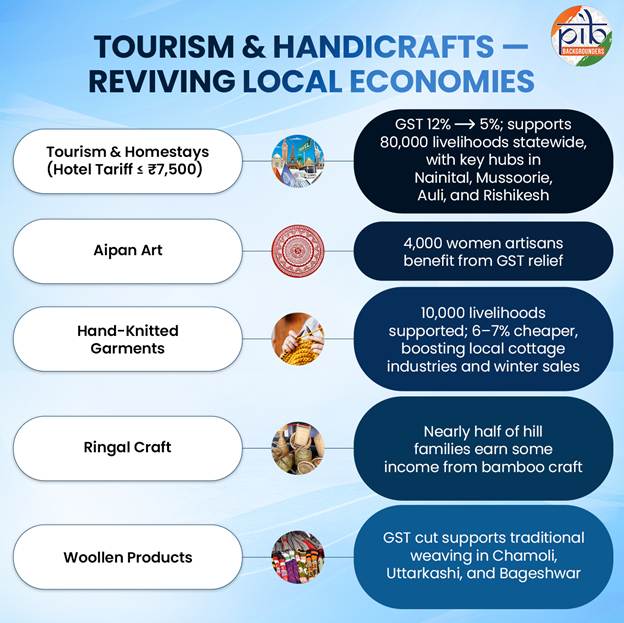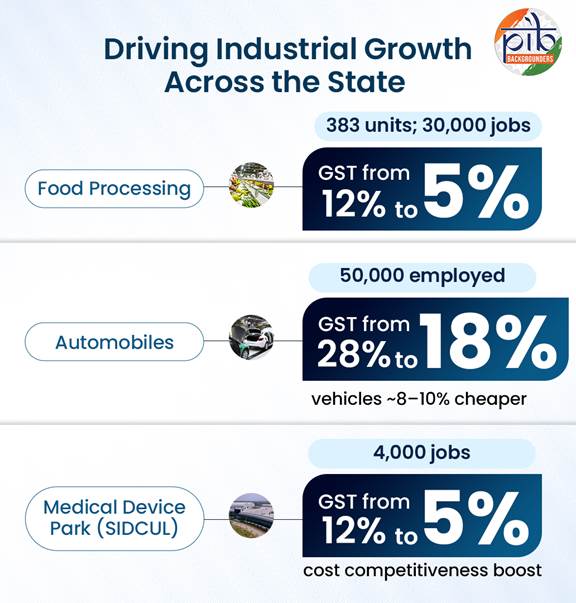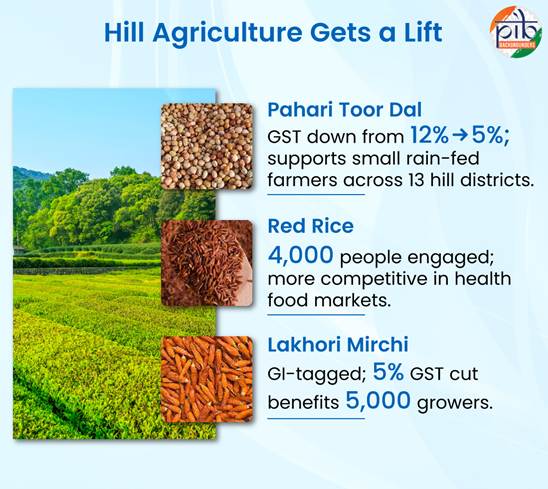Key Takeaways
|
Introduction
Nestled in the Himalayas, Uttarakhand is a state where terraced farms meet spiritual tourism, and ancient crafts blend with emerging industries. From the red rice fields of Purola to the bustling homestays of Nainital and Mussoorie, the state’s economy reflects a rich balance of nature, tradition, and enterprise.
The recent GST rate rationalisation provides a timely boost to this hill economy, reducing taxes across agriculture, tourism, crafts, and manufacturing. By lowering rates on key goods and services such as Pahari Toor Dal, Red Rice, Handicrafts, Woollen Garments, and Hospitality, the reforms aim to improve affordability, empower small producers, and attract investment to the state’s eco-friendly and high-value sectors.
The reform aligns with Uttarakhand’s vision of sustainable growth, fostering livelihoods in the hills while strengthening emerging industrial hubs in the plains.
Agriculture & Local Produce
Pahari Toor Dal
Grown across Chamoli, Almora, Tehri, Nainital, and Pithoragarh, Pahari Toor Dal is cultivated by small rain-fed farmers as part of the traditional Barahnaja mixed cropping system. Known for being organic and locally reputed, it is an essential ingredient in Uttarakhand’s traditional cuisine and is cultivated extensively across 13 hill districts.
With the GST rate reduced from 12% to 5%, prices are expected to become more affordable, making Pahari Toor Dal more competitive in organic and health food markets. This change is expected to encourage sustainable hill farming and improve income prospects for small and marginal farmers.
Uttarakhand Red Rice
Cultivated in Purola and Mori, Uttarakhand Red Rice is known for its traditional value and contribution to hill agro-biodiversity. With the GST rate reduced from 12% to 5%, prices are expected to become more competitive, particularly in packaged and health food markets. The change supports nearly 4,000 people directly and indirectly engaged in red rice farming, generating local employment and promoting sustainable hill agriculture.
Almora Lakhori Mirchi
The GI-tagged Lakhori Mirchi from Almora is known for its distinctive aroma and flavour. With the GST rate reduced from 12% to 5%, prices are expected to become more competitive, benefiting nearly 5,000 people directly and indirectly involved in its cultivation. The move supports local farmers and strengthens the market presence of this traditional hill spice.
Tourism & Cottage Industries
Tourism & Homestays
Tourism, including hotels and restaurants, contributes 13.57% to Uttarakhand’s GSDP and provides employment to nearly 80,000 people directly and indirectly. With the GST rate on hotel tariffs up to ₹7,500 reduced from 12% to 5%, the reform is expected to make travel more affordable and benefit small hotels, restaurants, and homestays across Nainital, Mussoorie, Auli, Chopta, Munsyari, Haridwar, and Rishikesh.
Aipan Art & Decorative Handicrafts
Practised across the Kumaon region, including Almora, Bageshwar, and Nainital, Aipan is a traditional wall and floor art now adapted into bags, wall hangings, and gift items. With the GST rate reduced from 12% to 5%, the reform is expected to benefit around 4,000 people, mainly women-led ventures, while supporting GI-tag promotion and expanding local handicraft markets.
Hand-Knitted Woollen Garments
Across Uttarakhand’s hill districts, locally hand-knitted sweaters, caps, and socks form an important seasonal cottage industry led by hill women. With the GST rate reduced from 12% to 5%, prices are expected to fall by 6–7%, supporting around 10,000 livelihoods and helping small producers earn better returns during the peak tourist season.
Ringal (Hill Bamboo) Craft
Produced mainly in Pithoragarh, Champawat, and Nainital, Ringal, a local dwarf bamboo, is used to make baskets, trays, and utility items. With the GST rate reduced from 12% to 5%, the reform supports SC/ST communities engaged in Ringal-based handicrafts. A study in the Garhwal Himalaya found that about 47.65% of hill families earn some income from Ringal or bamboo craft work, underscoring its role in sustaining rural livelihoods.
Traditional Woollen Products (Pankhi, Shawls, Stoles)
Handmade from local sheep wool in Chamoli, Uttarkashi, and Bageshwar, these traditional woollen items are integral to Uttarakhand’s craft heritage and rural livelihoods. The GST reduction from 12% to 5% is expected to boost sales through local fairs and online platforms, helping preserve traditional crafts and support hill women artisans who depend on this seasonal cottage industry.

Industry & Manufacturing
Food Processing
Uttarakhand has 383 registered food processing units, primarily located in Rudrapur, employing nearly 30,000 people. The GST rate reduction from 12% to 5% is expected to improve margins, encourage value addition, and promote investment in sectors such as fruit processing, herbal products, and organic foods, strengthening the state’s agro-industrial base.
Automobile Sector
The automobile manufacturing belt across Pantnagar, Rudrapur, Haridwar, and Kashipur employs nearly 50,000 people directly and indirectly. With the GST rate reduced from 28% to 18% on vehicles up to 1200cc (petrol) and 1500cc (diesel), prices are expected to fall by around 8–10%. This will stimulate domestic demand, support manufacturers, and create additional employment opportunities across the automobile value chain.
Medical Device Park
Located in the State Infrastructure and Industrial Development Corporation of Uttarakhand Limited (SIDCUL) industrial area, the Medical Device Park employs around 4,000 people engaged in manufacturing activities. The GST reduction from 12% to 5% on medical devices will lower production costs, boost competitiveness, and encourage investment in the healthcare manufacturing ecosystem, further strengthening Uttarakhand’s MedTech sector.

Conclusion
The GST reforms unlock wide-ranging benefits across Uttarakhand’s economy, from small hill farmers cultivating traditional crops to women artisans preserving Aipan and Ringal crafts, and from homestay owners in Rishikesh to industrial workers in Rudrapur.
By reducing tax burdens and improving competitiveness, the reforms will strengthen livelihood security, tourism, MSME growth, and green entrepreneurship. Together, these measures bridge the gap between the mountain and the market, advancing Uttarakhand’s vision of inclusive, sustainable, and self-reliant development.





